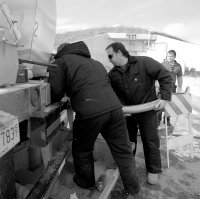 There’s been plenty of talk about using biodiesel in our vehicles. But some people might not know that the green fuel is good for keeping your home warm on these cold winter nights.
There’s been plenty of talk about using biodiesel in our vehicles. But some people might not know that the green fuel is good for keeping your home warm on these cold winter nights.
This story in the Eugene (OR) Register-Guard says one company in that area has overwhelming support for biodiesel as a home-heating oil:
Automatic Heat serves about 2,000 customers with oil furnaces, “and about 85 percent are using biodiesel — it’s pretty much clipping right along,” (Automatic Heat general manager Michael) Schilling said. “We offer our customers a B20 blend of 20 percent biofuel and 80 percent low-sulfur (diesel). We don’t go higher because, like cars, some fuel systems can’t handle more than that without modifications.”
Even at that level, the blend “makes a huge impact on emissions,” he said. Eventually, when heating systems that can run 99 percent biofuel become readily available, “if customers are educated about biofuel, I think they’ll want to change,” he said.
Before Automatic Heat began offering biodiesel heating oil two years ago, “we polled our customers and told them we were considering it,” Schilling said. “At that time, about 70 percent of them said they wanted it, even at premium prices.”
Proponents of oil-burning furnaces point out that they burn hotter and do a better job of warming a home than other fuels, such as natural gas. Plus, with cleaner-burning, low-sulfur diesels mixed biodiesels, the arguments about that sooty, diesel smell fall flat. And if that’s not enough, most home furnaces can easily burn B20 biodiesel, and with approval from a certified home heating technician, 99.9 percent biodiesel can be used.


 A survey conducted at the recent University of Minnesota’s E3 2007 Conference: The Midwest’s Premier Energy, Economic and Environmental Conference says attendees believe oil prices will be the primary driver of sustainable energy development and commercialization in the Midwest.
A survey conducted at the recent University of Minnesota’s E3 2007 Conference: The Midwest’s Premier Energy, Economic and Environmental Conference says attendees believe oil prices will be the primary driver of sustainable energy development and commercialization in the Midwest. Forty percent of the attendees surveyed believe oil prices will be the primary driver of sustainable energy development and commercialization.
Forty percent of the attendees surveyed believe oil prices will be the primary driver of sustainable energy development and commercialization.
 The Food and Energy Security Act of 2007 passed by the Senate last week includes increased funding for alternative energy sources.
The Food and Energy Security Act of 2007 passed by the Senate last week includes increased funding for alternative energy sources. 
 “We are excited about the opportunity to help showcase the advances being made in biofuels and the role they can play in the effort to reduce our nation’s reliance on petroleum,” said Paul Schickler, Pioneer president and DuPont vice president and general manager.
“We are excited about the opportunity to help showcase the advances being made in biofuels and the role they can play in the effort to reduce our nation’s reliance on petroleum,” said Paul Schickler, Pioneer president and DuPont vice president and general manager. A new message accompanies the ice resurfacing machine at University of Minnesota hockey games. The new “E85 Zamboni” debuted this month during a game between the Gopher Men and the University of Alaska-Anchorage.
A new message accompanies the ice resurfacing machine at University of Minnesota hockey games. The new “E85 Zamboni” debuted this month during a game between the Gopher Men and the University of Alaska-Anchorage.  The
The  About 55,000 students in the Philadelphia area will be riding to school on more than 500 buses fueled with biodiesel starting next year.
About 55,000 students in the Philadelphia area will be riding to school on more than 500 buses fueled with biodiesel starting next year. Diane Herrin, a West Chester mother of two, founded Moms for the Future with a few other mothers as an advocacy group. Environmental issues top the group’s docket at the moment.
Diane Herrin, a West Chester mother of two, founded Moms for the Future with a few other mothers as an advocacy group. Environmental issues top the group’s docket at the moment. National Wind, LLC, a leader in large-scale community-owned wind power projects is getting a boost in its capital from South Dakota-based Harmony Equity Income Fund.
National Wind, LLC, a leader in large-scale community-owned wind power projects is getting a boost in its capital from South Dakota-based Harmony Equity Income Fund. As part of its campaign to educate consumers and the news media, the
As part of its campaign to educate consumers and the news media, the